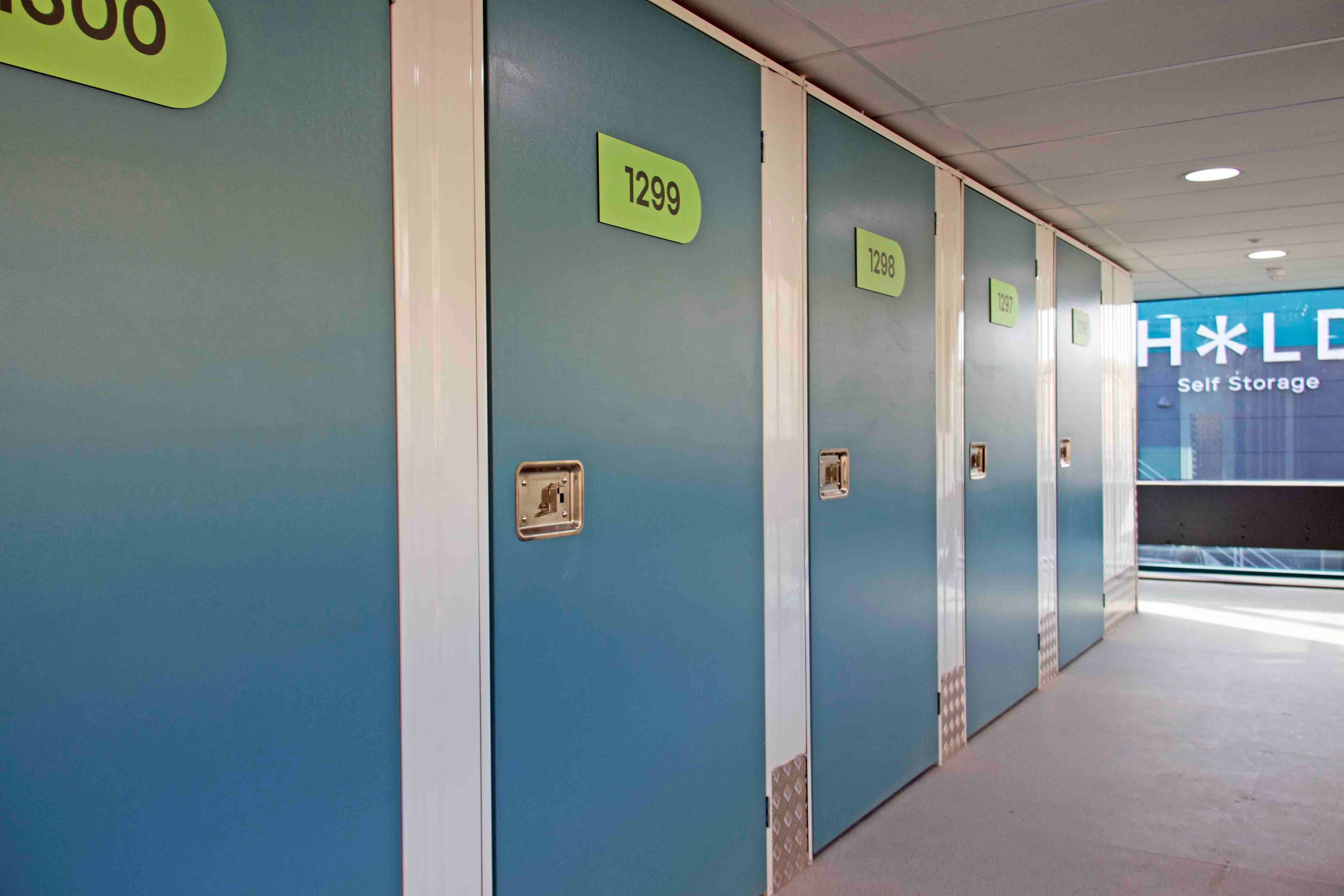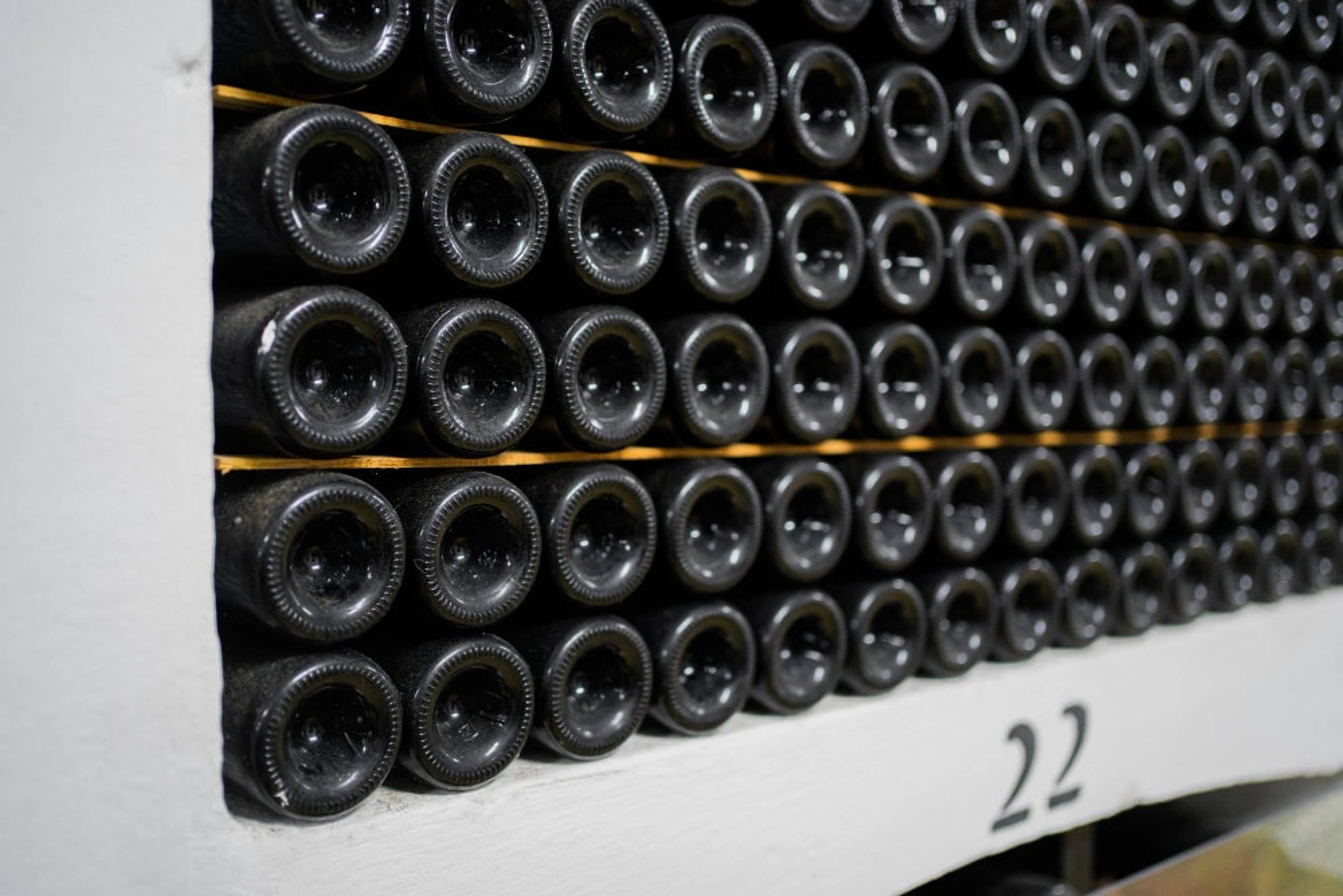Key takeaways
Keep champagne in a consistent, cool temperature, ideally between 10°C and 13°C.
Store bottles away from light, especially direct sunlight or fluorescent bulbs.
Use upright storage for short-term use (less than 1 month); use side storage for longer-term storage.
Limit exposure to vibrations and strong smells to protect flavour.
Use a champagne stopper for opened bottles and refrigerate for up to 3 days.
While not technically climate-controlled, HOLD storage units are temperature-regulated and suitable for storing wine and champagne.
Champagne is synonymous with celebration, but the joy can quickly fade if a bottle is spoiled before opening.
In this guide, you’ll learn exactly how to store Champagne to keep it tasting fresh and effervescent, whether it’s for next week’s toast or next year’s anniversary.
Why proper storage matters

Champagne is not like your average bottle of still wine. Its unique pressure, ageing process, and delicate balance of flavour make it highly sensitive to its surroundings.
Incorrect storage can lead to dull taste, flat bubbles, and even premature spoilage.
Bottles that are too warm lose their sparkle and complexity. Light can break down aromatic compounds, while dry environments may cause the cork to shrink, allowing oxygen in, the worst enemy of any wine.
For collectors, poor storage can also depreciate the bottle’s resale value, especially when storing half bottles or rare vintage cuvées.
Whether you're safeguarding a precious vintage or a few festive non-vintage Mumm Champagnes, proper storage is essential to maintain quality and avoid extreme temperature fluctuations.
How to store Champagne: core principles
Temperature and light
Consistent temperature is king.
Champagne thrives in stable environments. Ideal conditions range from 10°C to 13°C, but up to 15°C is tolerable as long as it's steady. Fluctuations, say, from a warm kitchen to a cold hallway, are more damaging than a slightly higher but constant temperature.
Avoid light at all costs.
Champagne is particularly vulnerable to "light strike," a chemical reaction caused by exposure to UV rays or fluorescent light. This can make it taste like damp cardboard or cabbage. Keep bottles in complete darkness or use a UV-protective film if stored at home.
Tips:
Don’t store champagne near appliances or on windowsills.
Use a wine fridge or wine rack in a dark place for home storage.
For bulk storage, opt for a professional wine flat or wine cellar like HOLD’s secure wine storage facilities.
Humidity control
Although champagne bottles have a wire cage securing the cork, they can still suffer from dried-out champagne corks in excessively dry spaces.
Optimal humidity lies between 50% and 70%.
This level prevents the cork from shrinking and maintains the internal pressure inside the bottle. If corks dry out, they lose their seal, exposing the contents to oxygen and eventually ruining the taste.
Solutions for dry environments:
Place a bowl of water nearby (but not touching the bottles) in cupboards or pantries.
In wine fridges, choose models with built-in humidity controls.
Be mindful not to allow too much humidity either, which can lead to mould or damaged labels.
Vibration and odour avoidance
Keep it calm and scent-free.
Champagne doesn’t like to be jostled. Repeated vibrations, from washing machines, subways, or even heavy foot traffic, can disturb sediments, accelerate chemical reactions, and dull the taste.
Odours also matter
Corks are porous. If champagne is stored near strong-smelling substances (cleaning products, paint, spices), it can absorb those scents, spoiling its delicate profile with unpleasant aromas.
Storage tips:
Avoid garage shelves and under-stair cupboards with motors or chemicals.
Choose a still, clean area with little disturbance for your bottles, horizontally or stored vertically.
Clear split: upright vs. side storage
Short-term storage (upright)

Planning to drink your Champagne within a few weeks? Keep it standing.
Why upright?
For bottles stored for under a month, upright positioning minimises surface area contact between the cork and wine, reducing the risk of cork taint or unwanted flavours. It’s also easier to access and label for events or gifts. This is generally recommended for short-term champagne storage.
When this works best:
Parties and celebrations
Gifts waiting to be delivered
New purchases not yet cellared
Long-term storage (sideways)

If your champagne is staying put for longer than a month, lie it down.
Why sideways?
Side or horizontal storage keeps the cork moist and swollen, maintaining an airtight seal that prevents oxidation. It’s the same reason traditional wine is stored horizontally.
Ideal for:
Vintage champagne
Ageing champagne blends for added complexity
Collectors and long-term drinkers
Any bottle stored in a wine cellar for years to come
Store your bottles horizontally in a cool place to maximise longevity.
Ageing versus fresh enjoyment
Know your bottles
Not all champagne improves over time. Most non-vintage varieties are blended for immediate enjoyment. On the other hand, vintage cuvées are designed to evolve and gain nuance with age.
Vintage vs. non-vintage:
Non-vintage: Drink within 1–2 years for freshness and fizz.
Vintage: Can be aged 5–10 years or more, depending on the producer.
Bottle size matters too.
Magnums, jeroboams, and other large bottles age more slowly due to lower oxygen-to-liquid ratios, often resulting in smoother, more elegant wines. This is especially helpful when ageing Champagne over decades in a stable storage area.
Leftover Champagne: Storage tips

It’s rare, but it happens. A half-finished bottle at the end of a lovely evening.
Best way to store it?
Use a champagne stopper, which creates a seal strong enough to preserve carbonation.
Refrigerate immediately, keeping the bottle upright in a cool and dark place.
How long will it last?
2–3 days, at most. After that, the bubbles will fade and the flavours will turn flat. For the best taste, try to finish it within 24 hours.
Common storage mistakes to avoid
Avoid these common pitfalls to keep your champagne in pristine condition:
Fridge storage for more than a few days: Too cold and too dry.
Direct sunlight or light exposure: Even short exposure can cause damage.
Storing near heat sources: Radiators and ovens are a no-go.
Inconsistent or fluctuating temperatures: Avoid extreme temperature fluctuations.
Upright storage for ageing: This can lead to dried corks over time.
Conclusion
Storing champagne isn’t just about preserving bubbles; it’s about honouring the time, craftsmanship, and occasion behind every bottle.
With just a few mindful steps, you can ensure that each sip delivers the freshness and finesse intended by its maker.
Whether you’re building a collection or saving something special, the right storage approach can make all the difference.
HOLD Self Storage is here to help

Whether you're ageing vintage bottles or keeping a few on hand for special occasions, HOLD provides secure, temperature-regulated storage in London designed perfectly for Champagne and fine wines. You can explore our wine storage options at HOLD’s wine storage.
Frequently asked questions
How do I know if my champagne has gone bad?
Look for flat bubbles, off-smells (like damp cardboard or vinegar), and a cloudy appearance. A quick taste will confirm – spoiled Champagne loses its sparkle and balance.
Can I store champagne in a regular fridge?
Only for 1–2 days. The low temperature and dry air will damage the cork if used long-term. It’s best to move it to a cool, dark cupboard or invest in a wine fridge.
Does champagne always get better with age?
No. Most non-vintage bottles are best drunk young. Only vintage Champagnes and certain prestige cuvées are crafted to age well. Even Mumm Champagnes vary – check the label or consult the producer.
Does HOLD offer proper conditions for storing champagne?
Yes. While we don't have climate control, our wine storage facilities are temperature-regulated, dark, and vibration-free. We meet the standards for storing champagne safely under controlled storage conditions.
Can I store other sparkling wines at HOLD?
Absolutely. HOLD’s wine storage is designed to accommodate all types of fine wine, including Prosecco, English sparkling wine, and vintage champagne. Even bottles you’ve picked up near the Baltic Sea are safe with us.

